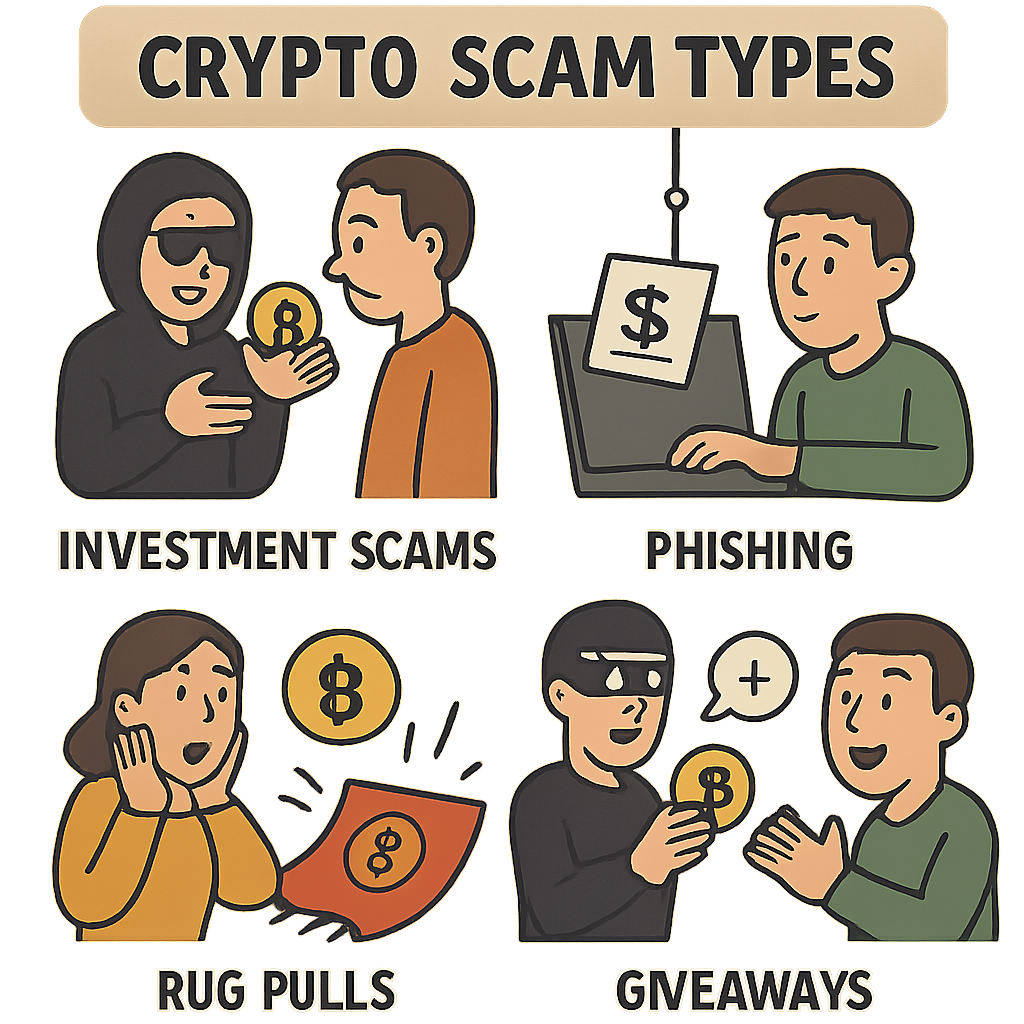Recover Funds From Crypto Scam 2026
Cryptocurrency has revolutionized the financial world. It offers new opportunities for investment and wealth creation. But with these opportunities come risks.
Crypto scams are on the rise. They target both new and experienced investors. The decentralized nature of digital currencies makes them attractive to fraudsters.
Recovering funds from a crypto scam can be daunting. Many victims feel helpless and unsure of where to start. But recovery is possible with the right steps.
Understanding the types of scams is crucial. Phishing, Ponzi schemes, and fake exchanges are common. Each scam involves unique tactics to deceive victims.
Acting quickly is essential. The longer you wait, the harder recovery becomes. Immediate action can increase the chances of retrieving lost funds.
Reporting the scam to authorities is a vital step. It helps in tracking down the perpetrators. It also aids in preventing future scams.
Legal options and crypto recovery services can assist victims. They offer expertise and resources for navigating the complex recovery process. However, caution is needed to avoid further scams.
Education and awareness are key to prevention. Knowing the red flags and security measures can protect your investments. Stay informed and vigilant in the evolving crypto landscape.
Understanding Crypto Scams: What Every Investor Should Know
Cryptocurrency scams have become increasingly sophisticated. They exploit the rapid growth and anonymity of digital currencies. Understanding these scams is the first line of defense for investors.
Fraudsters use a variety of tactics to deceive victims. Knowing these tactics can help in identifying potential threats early. Let’s explore some common scam techniques.
Scammers often replicate well-known crypto platforms. They create fake websites and social media profiles. This can mislead investors into sharing their sensitive information.
Phishing scams are prevalent in the crypto world. They involve fake emails that appear legitimate. These emails prompt users to provide passwords or private keys.
Ponzi schemes lure investors with promises of high returns. They rely on recruiting new investors to pay off old ones. Eventually, the scheme collapses, leaving victims with losses.
Fake exchanges promise low fees and lucrative trading opportunities. However, these exchanges eventually vanish with all the funds. Verification of the exchange’s authenticity is crucial.
Here are some key tactics scammers use:
- Impersonation: Mimicking trusted figures or companies.
- False promises: Offering guaranteed returns with no risk.
- Pressure tactics: Creating a sense of urgency to invest quickly.
- Complex jargon: Confusing terms that obscure the scam’s simplicity.
Investors need to stay informed about these tactics. They should research and verify platforms before engaging. Community forums and online reviews can be helpful.
Security measures can also provide protection. Using secure wallets and enabling two-factor authentication are recommended. Regular updates to software and cautious online behavior are essential.
In essence, knowledge is power. The more aware investors are, the better they can protect themselves. Staying up-to-date with the latest scam developments is vital.
Understanding crypto scams is a continuous process. New types of scams appear regularly as technology evolves. Adapting to these changes can prevent financial losses and protect assets.
Common Types of Crypto Scams in 2026
The world of cryptocurrency is rapidly evolving. Unfortunately, this growth attracts scammers who develop new fraud techniques. Identifying these scams is crucial for any investor.
In 2026, several crypto scams have emerged and evolved. They exploit the intricate nature of digital currencies and blockchain technology. Awareness of these scams is key to protecting assets.
Phishing Scams
Phishing scams remain a significant threat. They trick individuals into providing sensitive information. Cybercriminals often use fake emails or websites to impersonate legitimate crypto services.
Ponzi Schemes
Ponzi schemes continue to deceive investors. Promising high returns with minimal risk, they rely on the inflow of new investments to pay existing investors. Eventually, they collapse when recruitment slows.
Fake Exchanges
Fake exchanges are increasingly common in 2026. These platforms promise low fees and high returns. However, they vanish with users’ funds, leaving victims without recourse.
Rug Pulls
A newer scam is the “rug pull.” This occurs in decentralized finance (DeFi) projects. Developers abandon a project after securing significant investment, leading to catastrophic losses for investors.
Giveaway Frauds
Giveaway scams often involve social media platforms. Scammers impersonate celebrities, announcing fake giveaways that require a “small” initial deposit to participate. Once deposited, the scammers disappear.
NFT Frauds
Non-fungible tokens (NFTs) have become a new target. Scammers sell counterfeit or nonexistent NFTs to unsuspecting buyers. This type of scam exploits the novelty and hype surrounding digital art and collectibles.
Scam Tactics Used
Let’s explore some tactics scammers employ:
- Spoofing: Using fake identities to impersonate service providers.
- Manipulation: Creating fake market movements to trick traders.
- Social Engineering: Exploiting human psychology to gain trust and extract information.
To guard against these scams, investors should take proactive steps. Verifying the legitimacy of platforms and projects is crucial. Using blockchain explorers can also help track transaction histories and confirm authenticity.
Furthermore, engaging with crypto communities can provide insights. Forums and social media groups often discuss suspicious activities. These platforms can offer advice and warnings about ongoing scams.
In conclusion, staying informed is vital to combating crypto fraud. As new scam methods continue to develop, vigilance and awareness remain the best defenses. Understanding these scam tactics can significantly reduce the risk of falling victim.
How a Crypto Scam Involves Victims: Tactics and Red Flags
Crypto scams often involve elaborate tactics. Scammers employ a mix of technology and psychology. Understanding these methods can help investors avoid losing money.
One common tactic is impersonation. Scammers pretend to be reputable figures or institutions. They use convincing stories to build trust and credibility quickly.
Another method involves urgency. Scammers often push victims to act fast. They create a sense of scarcity or limited-time offers to pressure decision-making.
Scammers also exploit technical loopholes. They manipulate transaction paths to cover tracks. Using complex networks, they make it hard to trace stolen funds.
Social engineering is a critical aspect. Scammers study human behavior and exploit weaknesses. This manipulation can persuade even savvy investors.
Red flags often signal potential scams. Lack of transparency is one. If an offer seems too good to be true, it probably is. Scrutinizing every detail is crucial.
Key Red Flags to Watch For
- Promises of guaranteed returns: No investment is 100% safe.
- Unsolicited offers: Direct contact with offers is a warning sign.
- Lack of verifiable information: Genuine businesses have a solid digital footprint.
- Vague details about operations: Legitimate projects offer clear plans and regular updates.
- Pressure to invest quickly: Scams thrive on rushed decisions.
Investors can take specific steps to protect themselves. Performing due diligence on any offer is essential. Research and verifying each claim can save a lot of trouble.
Using secure networks and keeping systems updated also helps. Regularly reviewing account security settings is wise. Strong passwords and two-factor authentication are vital.
Communicating with trusted networks can provide extra security. Sharing suspicious experiences enhances awareness among peers. This communal vigilance helps everyone stay safer in the crypto space.
Ultimately, education is the best defense against scams. By staying informed about the latest fraud techniques, investors can detect and avoid scams. Awareness enables them to protect their assets effectively.
Immediate Steps to Take After Falling Victim to a Crypto Scam
Realizing you’ve fallen victim to a crypto scam can be distressing. Acting swiftly is crucial in these situations. Prompt action can increase the chances of recovery.
First, document every detail. Capture all communication and transaction records. Screenshots, emails, and chat logs are valuable evidence.
Immediately report the incident to your crypto exchange or platform. Some platforms can freeze accounts. This measure may prevent further unauthorized transactions.
Next, change your account passwords. Update logins for any accounts associated with your crypto wallets. This step safeguards against further breaches.
Consider notifying your bank or credit card provider. While crypto transactions are irreversible, linked financial accounts may still be protected. Informing them helps in monitoring unusual activity.
Listing down the agencies and organizations that handle such scams is essential. Here are some steps to help guide this process:
- Contact the platform: Notify them of the scam immediately.
- Change passwords: Update all login credentials promptly.
- Inform financial institutions: Alert banks to monitor accounts.
- Freeze accounts: Request a halt on any ongoing transactions.
Reach out to relevant authorities. Report the scam to financial regulators and local law enforcement. Reporting bolsters efforts to combat scams globally.
Consider consulting a crypto-savvy lawyer. Legal advice can clarify options and potential recourse. A lawyer can guide you through complex legal channels.
Agencies and Organizations to Contact
- Federal Trade Commission (FTC): For scams involving U.S. residents.
- Local law enforcement: File a report to initiate legal action.
- Financial Conduct Authority (FCA): If in the U.K., report financial scams.
- Internet Crime Complaint Center (IC3): Specialized in internet fraud cases.
- Crypto exchanges: Inform them and inquire about recovery possibilities.
Remember, speed is of the essence. Delays diminish the chances of fund recovery. Acting promptly protects your remaining resources and enhances recovery potential.
Finally, stay calm. Though stressful, a clear mind aids in decision-making. Each step taken improves chances of recovering funds or at least preventing further losses. By being proactive, you are safeguarding not only your assets but also contributing to the global fight against crypto scams.
Reporting the Scam: Authorities and Organizations to Contact
After encountering a crypto scam, reporting it to the proper authorities is vital. Reporting helps in tracking cybercriminals and assists in your recovery efforts.
Start by contacting your country’s financial regulatory body. They can advise on the proper channels and may handle financial fraud cases. For example, the Securities and Exchange Commission (SEC) in the U.S. deals with fraud related to investments.
Local law enforcement should also be informed. While crypto crimes are digital, they have real-world implications. Filing a police report documents the scam and helps establish a legal basis for recovery efforts.
Furthermore, consider reaching out to specialized internet crime units. Bodies like the Internet Crime Complaint Center (IC3) can offer guidance. They focus on crimes related to the internet, including crypto scams.
If you are in the U.K., the Financial Conduct Authority (FCA) is your go-to. They regulate financial firms and ensure consumer protection against fraud. Reporting there can contribute to broader efforts against scammers.
Useful Contacts for Reporting Crypto Scams:
- Securities and Exchange Commission (SEC)
- Internet Crime Complaint Center (IC3)
- Financial Conduct Authority (FCA)
- Local Law Enforcement Agencies
- Federal Trade Commission (FTC)
It’s also wise to inform your crypto wallet provider or exchange. They might have protocols to trace or freeze transactions. Some may offer additional guidance or services for recovery.
For international cases, Interpol can play a role. They have a cybercrime division that works globally. International cooperation is key, as many scammers operate across borders.
Through coordinated reporting, victims increase pressure on authorities to act against scam networks. Reporting is more than a personal battle; it’s a contribution to dismantling wider criminal networks.
Ultimately, effective reporting is a cornerstone in the fight against crypto scams. Sharing your experience aids in preventing similar scams from affecting others, fostering a safer crypto environment for everyone.
Blockchain Analysis: Tracing and Tracking Stolen Crypto Funds
Blockchain technology, while complex, provides transparency with every transaction recorded on an immutable ledger. This transparency is a double-edged sword, offering both challenges and opportunities for tracing stolen crypto funds.
When a scam occurs, transactions involved are embedded in the blockchain. Skilled analysts leverage blockchain explorers to track these movements. Such tools reveal transaction histories, addresses involved, and sometimes, the final destination of stolen funds.
Blockchain analysis doesn’t end with identifying addresses. It involves interpreting data and understanding the context of movements. Patterns can suggest certain behaviors, such as funds being shuffled to obscure their origin.
Chainalysis and CipherTrace are popular blockchain analysis companies. They specialize in providing insights and tracing techniques. These firms work with law enforcement and financial institutions to combat crypto crime.
Key Tools in Blockchain Analysis:
- Blockchain Explorers: Search and view transaction histories.
- Analysis Software: Track complex transaction patterns.
- Forensic Services: Specialized analysis for legal proceedings.
For victims, these analyses often mean the difference between recovery and permanent loss. Experts can pinpoint addresses where scammed funds were transferred.
However, human diligence is equally important. Aligning blockchain analysis with legal processes maximizes recovery chances. Authorities may use these insights alongside other evidence, helping to build a case.
While some scammers employ sophisticated methods to conceal their tracks, blockchain analysis remains a critical tool. With growing collaboration, the reach of investigators deepens.
In conclusion, blockchain analysis is a beacon of hope for victims of crypto fraud. It underscores that, despite the sophisticated nature of digital crimes, recovery is possible with the right tools and expertise. As technology evolves, so too does our ability to combat crypto scams effectively.
Legal Options: Working with Law Enforcement and Crypto Lawyers
When victims of a crypto scam seek recovery, legal pathways can offer avenues for justice. Engaging the right legal framework is crucial for reclaiming lost funds effectively.
Initial steps should involve reporting to law enforcement. Organizations like the Federal Trade Commission (FTC) or local police can document the scam. They gather evidence that helps build a robust case.
Crypto-focused lawyers play a pivotal role, especially those with experience in digital currencies. These experts understand the nuances of cryptocurrency laws. They guide victims through legal proceedings.
Legal professionals can also collaborate with law enforcement. Their joint efforts ensure that all aspects of the scam are investigated. This partnership strengthens the chances of recovering funds.
Victims have legal recourse through civil litigation against scammers. While the process can be lengthy, it provides a structured approach to seek compensation. Both individuals and groups have pursued this route with varying success.
Benefits of Legal Action:
- Professional Guidance: Expertise in crypto laws and regulations.
- Documentation: Proper recording and filing of evidence.
- Civil Litigation: Potential for monetary recovery.
Moreover, international collaboration is key. As crypto scams often operate cross-border, global cooperation is essential. Many countries are now sharing intelligence to tackle such crimes.
Victims should remain cautious. The legal journey requires patience and perseverance. However, with skilled lawyers and coordinated efforts, recovery is feasible.
The rise in crypto scams has necessitated legal adaptation. Laws continue to evolve, aiming to better protect investors. Legislative efforts reinforce the commitment to combating digital fraud.
Overall, leveraging legal options is an essential component of crypto scam recovery. It offers a structured framework and expert guidance in the complex digital realm. Engaging law enforcement and crypto lawyers provides victims with a beacon of hope for justice. Through these avenues, the path to recovery becomes clearer and more attainable.
Crypto Recovery Services: What They Offer and How to Choose Wisely
Crypto recovery services have emerged as a valuable resource for victims of crypto scams. These services specialize in retrieving lost or stolen digital funds, leveraging specific skills and technology.
A key offering from recovery services is transaction analysis. They utilize advanced tools to track and trace stolen crypto across blockchain networks. This helps pinpoint potential locations of the pilfered assets.
In addition, these services often collaborate with blockchain forensics firms. Forensic experts dive deep into transaction histories and identify illicit activity. Such scrutiny is essential for piecing together the scam puzzle.
However, choosing a reliable recovery service requires diligence. Research the reputation and success rates of potential candidates. Not all services deliver on their promises, and some may even be scams themselves.
Victims should assess whether a service offers personalized guidance. The best recovery services tailor their approach to each case. Customized strategies improve the likelihood of successful fund recovery.
Fees and payment structures vary widely. It’s vital to understand the terms before engaging a service. Ensure transparency regarding costs to avoid being caught off-guard later.
What to Look For in a Recovery Service:
- Experience and Expertise: Proven track record in crypto recovery.
- Client Reviews: Positive feedback from past clients.
- Transparency: Clear communication about fees and processes.
Furthermore, privacy and confidentiality are paramount. Verify that the recovery service prioritizes protecting sensitive client information. Trustworthy services will have stringent data protection protocols.
Services may provide complementary consultation, which allows victims to evaluate their approach. Use these sessions to gauge professionalism and expertise. This initial assessment can be critical in the decision-making process.
Finally, patience is necessary throughout the recovery journey. Results may not be immediate, as legal and technical hurdles are common. Trust in the chosen service’s expertise, and stay informed about progress.
By choosing wisely, victims maximize their chances of recovering lost crypto assets. The right recovery service offers a blend of technology, expertise, and strategic acumen essential for navigating the complexities of the crypto world.
DIY Recovery: Tools and Techniques for Individuals
Recovering lost crypto funds can be daunting, but some individuals choose the DIY route. With the right tools and techniques, self-guided recovery is possible.
One of the first steps in DIY recovery is blockchain exploration. Online explorers allow you to trace the movement of your funds across blockchain networks. These tools can identify where your funds have gone.
Alongside tracking, analyzing transaction history is crucial. Detailed examination reveals patterns or irregularities, offering clues about unauthorized transactions. Familiarity with transaction IDs and wallet addresses aids this process.
Additionally, leveraging community support can be beneficial. Online forums and crypto communities often share recovery tips and experiences. Engaging with these communities provides insights and moral support.
DIY Recovery Tools:
- Blockchain Explorers: Trace transactions and flow.
- Crypto Forums: Share experiences and get advice.
- Wallet Security Audits: Check for vulnerabilities.
Conducting a security audit on your wallets is also important. It helps identify vulnerabilities that might have been exploited. Implementing stronger measures can prevent future breaches.
For those with technical know-how, using open-source forensic tools can further recovery efforts. These tools assist in dissecting complex scams. However, they often require a deeper understanding of blockchain dynamics.
Despite the potential effectiveness, DIY recovery is fraught with challenges. It requires significant time and technical skills. Victims should weigh their ability to handle these tasks against seeking professional assistance.
Ultimately, a blend of determination, technology, and community wisdom is essential for DIY recovery. By carefully following these strategies, individuals enhance their chances of reclaiming lost crypto assets.
Preventing Future Losses: Security Best Practices for Crypto Investors
Preventing future losses in the crypto world demands vigilance and a proactive approach. Investors must fortify their defenses to deter scammers.
A critical step is adopting strong password practices. Use unique and complex passwords for all accounts related to crypto activities. Regularly updating these passwords is also crucial to enhance security.
Password Security Tips:
- Use a password manager to handle multiple accounts.
- Enable two-factor authentication where possible.
- Avoid using easily guessable information in passwords.
Employing secure wallets is another essential strategy. Hardware wallets provide a robust layer of security by keeping private keys offline. This significantly reduces the risk of online hacks.
Equally important is staying informed about prevalent scams and evolving threats. Regularly reading crypto news and reports helps you stay ahead of scammers’ tactics. Awareness is a powerful tool against deception.
Staying Informed:
- Subscribe to credible crypto news sources.
- Participate in crypto webinars or workshops.
- Join online communities for the latest updates.
Network security plays a pivotal role in safeguarding your assets. Be cautious when accessing your accounts over public or unsecured Wi-Fi networks. Using a VPN adds an extra security layer to your online activities.
Lastly, approach all investment opportunities with skepticism. Conduct thorough research before committing your funds. Verify the legitimacy of the companies or platforms you intend to invest in.
In the ever-evolving crypto space, taking these measures is indispensable. A vigilant investor is less likely to fall victim to cunning scams. By prioritizing security, investors safeguard their assets and promote a safer crypto community.
Real-Life Case Studies: Successful Crypto Scam Recoveries
Real-life case studies provide invaluable insights into crypto scam recoveries. They show how determination and proper strategies lead to success.
One notable case involves a victim of a phishing scam who recovered substantial funds. After realizing their funds were stolen, they immediately contacted the exchange. Quick action allowed them to freeze the account, preventing further loss.
In another instance, an investment scam targeted numerous crypto enthusiasts. Victims united and hired a legal team with crypto expertise. Together, they pursued justice by working closely with authorities and international agencies.
Key Elements of Recovery Success:
- Promptly reporting scams to relevant exchanges.
- Collaborating with specialized legal teams.
- Utilizing blockchain analysis to trace funds.
Community efforts have also brought about successful recoveries. In a recent case, victims banded together on social forums. They pooled resources to employ blockchain analysts who traced funds back to a fake exchange.
These stories emphasize that collective effort is sometimes key to recovering stolen assets. Networking with fellow victims can enhance the chances of success.
Examining these cases highlights the importance of decisive action and coordinated efforts. Victims who act swiftly, utilize technological tools, and seek expert help often recover their assets. These successful recoveries inspire hope and confidence within the crypto community.
Frequently Asked Questions About Crypto Scam Recovery
Crypto scam recovery is fraught with complexities and uncertainties. Understanding common concerns helps in navigating this challenging path.
What is the first step after realizing you’ve been scammed?
Immediate action is crucial. As soon as you suspect a scam, report it to the platform involved. This can help in preventing further loss.
Can stolen crypto always be recovered?
Recovery isn’t guaranteed. However, taking swift steps and leveraging expert resources can increase the odds. Success depends on various factors, including the scam’s nature.
Are crypto recovery services reliable?
Some recovery services provide genuine help, but be cautious. Research their reputation and client reviews thoroughly. Scammers often pose as recovery agents themselves.
What role do authorities play in the recovery process?
Authorities can freeze accounts, conduct investigations, and collaborate internationally. Reporting scams to law enforcement can be pivotal. They offer support and legitimacy in confronting scammers.
Common Questions to Consider:
- What preventative measures can you take?
- How does blockchain analysis aid recovery?
- Why is it vital to stay informed about new scam tactics?
These FAQs illustrate the frequent challenges and questions that victims encounter. Understanding these can aid in the recovery journey and in preventing future scams. Proactive measures and informed decisions make a significant difference in dealing with crypto scams.
Conclusion: Staying Safe and Informed in the Evolving Crypto Landscape
The world of cryptocurrency is fast-moving and laden with both opportunity and risk. As digital assets grow popular, scams evolve in complexity, targeting new and veteran investors alike.
Staying informed is your best defense against these scams. Keep updated on current trends and known threats in the crypto community. This empowers you to recognize and avoid potential fraud.
Security best practices are vital. Use secure wallets, enable two-factor authentication, and maintain software updates. These measures safeguard your investments against unauthorized access.
Education and vigilance are keys to navigating the crypto landscape safely. By combining knowledge with proactive strategies, you can protect your assets while maximizing the benefits of cryptocurrency. As the digital world transforms, your commitment to security must remain steadfast and adaptable.












